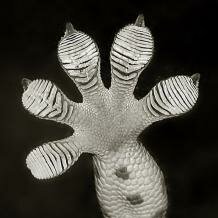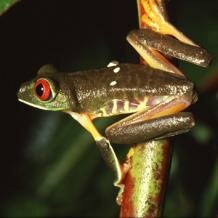Topic: Adhesive pads: from geckos to spiders
In terms of adhesive pads we find they have a remarkably wide distribution evolving in at least four distinct groups, including members of the reptiles, amphibians, arthropods and mammals, with tentative parallels in sea urchins.
 Anybody who has seen a gecko lizard running effortlessly across the ceiling, or for that matter a fly climbing a vertical pane of smooth glass, must have wondered how these very different animals manage to adhere so effectively but in addition can readily walk (or run) with the obvious implication that a power of adhesion can be reversed almost instantly. Not surprisingly the adhesion of feet (and sometimes other structures) turns out to be rampantly convergent, with the same solution being repeatedly re-invented. Not, of course, that this is the only method of hanging on and other structures, notably claws and suckers are also widely used, and they too are repeatedly re-invented (as in a different way are prehensile tails).
Anybody who has seen a gecko lizard running effortlessly across the ceiling, or for that matter a fly climbing a vertical pane of smooth glass, must have wondered how these very different animals manage to adhere so effectively but in addition can readily walk (or run) with the obvious implication that a power of adhesion can be reversed almost instantly. Not surprisingly the adhesion of feet (and sometimes other structures) turns out to be rampantly convergent, with the same solution being repeatedly re-invented. Not, of course, that this is the only method of hanging on and other structures, notably claws and suckers are also widely used, and they too are repeatedly re-invented (as in a different way are prehensile tails).
In terms of adhesive pads we find they have a remarkably wide distribution evolving in at least four distinct groups, including reptiles, amphibians, arthropods and mammals, with tentative parallels in sea urchins. At least in the case of the lizards, insects and amphibians adhesive pads also appear to have evolved multiple times. There are two distinct types of adhesive pad, the hairy and the smooth, and here too unexpectedly we see that each has emerged a number of times independently.
Adhesion in lizards
 Amongst the adhesive pads that are hairy probably the best known are those of the gecko feet, although the ability to adhere in a similar fashion has evolved at least twice more independently amongst the lizards, specifically amongst the anolid lizards (which amongst the representative on the various Caribbean islands provide more superb insights in convergence by virtue of the recurrent evolution of ecomorphs) and also some arboreal skinks found in the Solomon Islands and Papua New Guinea. The last group are the less adept climbers, and this is evidently due to the simpler structure of their adhesive pads. Those of the anolids and geckos, however, are very similar and in each case depend upon a profusion of hair-like extensions that can tightly bond onto almost any surface by virtue of a molecular force (van der Waals). The geckos, nevertheless, have the edge in terms of grip and agility, and this is probably a reflection of a particular ability to fold and unfold their foot-pads so allowing an almost instantaneous shift from grip to release. The ability of geckos to hold on is almost legendary, and includes observations of their gliding from trees and seizing a leaf with a single foot-pad to break their fall. In addition, some geckos augment their adhesive ability with similar pads on their tails. Not surprisingly the extraordinary grip of the geckos has inspired biotechnological imitations, although to date the success of the artificial mimics has been relatively limited except on a very small scale.
Amongst the adhesive pads that are hairy probably the best known are those of the gecko feet, although the ability to adhere in a similar fashion has evolved at least twice more independently amongst the lizards, specifically amongst the anolid lizards (which amongst the representative on the various Caribbean islands provide more superb insights in convergence by virtue of the recurrent evolution of ecomorphs) and also some arboreal skinks found in the Solomon Islands and Papua New Guinea. The last group are the less adept climbers, and this is evidently due to the simpler structure of their adhesive pads. Those of the anolids and geckos, however, are very similar and in each case depend upon a profusion of hair-like extensions that can tightly bond onto almost any surface by virtue of a molecular force (van der Waals). The geckos, nevertheless, have the edge in terms of grip and agility, and this is probably a reflection of a particular ability to fold and unfold their foot-pads so allowing an almost instantaneous shift from grip to release. The ability of geckos to hold on is almost legendary, and includes observations of their gliding from trees and seizing a leaf with a single foot-pad to break their fall. In addition, some geckos augment their adhesive ability with similar pads on their tails. Not surprisingly the extraordinary grip of the geckos has inspired biotechnological imitations, although to date the success of the artificial mimics has been relatively limited except on a very small scale.
Adhesion in tree-frogs
 Apart from the gecko and other lizards, the vertebrates that are best known for their adhesive pads are the frogs, notably the arboreal tree-frogs. Unlike the hairy pads of these reptiles, however, those of the frogs are smooth, and like the insects the pads also secrete a fluid (unlike the dry pads of lizards and spiders). Although the adhesive pads in tree-frogs are generally very similar, and typically have a hexagonal pattern (as do some insect pads), it is clear that they have evolved independently several times (as indeed has the arboreal habit of these amphibians).
Apart from the gecko and other lizards, the vertebrates that are best known for their adhesive pads are the frogs, notably the arboreal tree-frogs. Unlike the hairy pads of these reptiles, however, those of the frogs are smooth, and like the insects the pads also secrete a fluid (unlike the dry pads of lizards and spiders). Although the adhesive pads in tree-frogs are generally very similar, and typically have a hexagonal pattern (as do some insect pads), it is clear that they have evolved independently several times (as indeed has the arboreal habit of these amphibians).
Adhesive pads in insects
It is among the insects we see to best advantage the multiple acquisition of both hairy pads, similar to the geckos and other lizards, and smooth pads (as independently they have evolved several times in the frogs). In the case of the smooth pads of insects a repeated feature is that the adhesive surface is very soft, but unlike the geckos (and spiders) where the pads are completely dry, in the insects there is an associated fluid that is secreted through the pad. So too amongst the hairy pads of insects, which again have evolved several times, a fluid is secreted which has a rather special property of being composed of an immiscible mixture of hydrophilic and hydrophobic material.  These insect pads are extraordinarily effective, but there is one situation where they are generally useless, and that is when they encounter the lethal slippery rim of a carnivorous plant.
These insect pads are extraordinarily effective, but there is one situation where they are generally useless, and that is when they encounter the lethal slippery rim of a carnivorous plant.
Adhesive pads (scopula) in spiders
Although amongst the arthropods it is the adhesive pads of the insects that are best documented, we find the independent evolution of hairy adhesive pads (or scopula) in the spiders. They have a further interesting difference from the insect equivalents because the spiders do not employ an associated fluid, and in this sense are much more similar to the adhesive pads of the geckos and other lizards. In addition to providing a grip on otherwise inaccessible surfaces, the adhesive pads of the spiders are also used to hold prey.
 Adhesion in gliding mammals and bats
Adhesion in gliding mammals and bats
Adhesive pads have also evolved at least twice in the mammals. Specifically, the marsupial Feathertail Glider (Acrobates pygmaeus) has adhesive pads that use sweat as the fluid and some bats (vespertilionids) such as Tylonycteris have adhesive thumbs. Other bats use different methods of attachment, in one case being convergent on the sucker of an octopus (Cephalopoda).
Adhesive discs of echinoderm tube-feet
An interesting convergence on adhesive pads is found in the tube feet of echinoderms, critical for both respiration and locomotion. Echinoderm tube feet are soft structures lined with longitudinal muscle and controlled hydrostatically from an inflation sac or ‘ampulla’ beneath the pore pair from which each arises. The tip of each tube forms a prehensile disc, useful during movement and foraging. These soft adhesive discs are reminiscent of equivalent structures in the smooth adhesive pads of insects and tree frogs (although the secretory regime of the echinoderms is somewhat different).
Cite this web page
Map of Life - "Adhesive pads: from geckos to spiders"
https://mapoflife.org/topics/topic_275_adhesive-pads-from-geckos-to-spiders/
November 29, 2020

